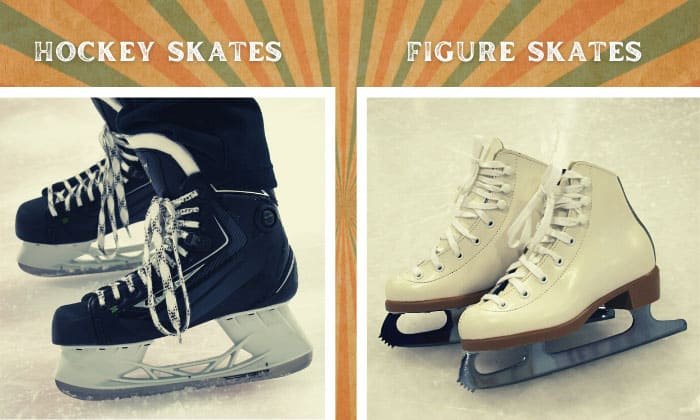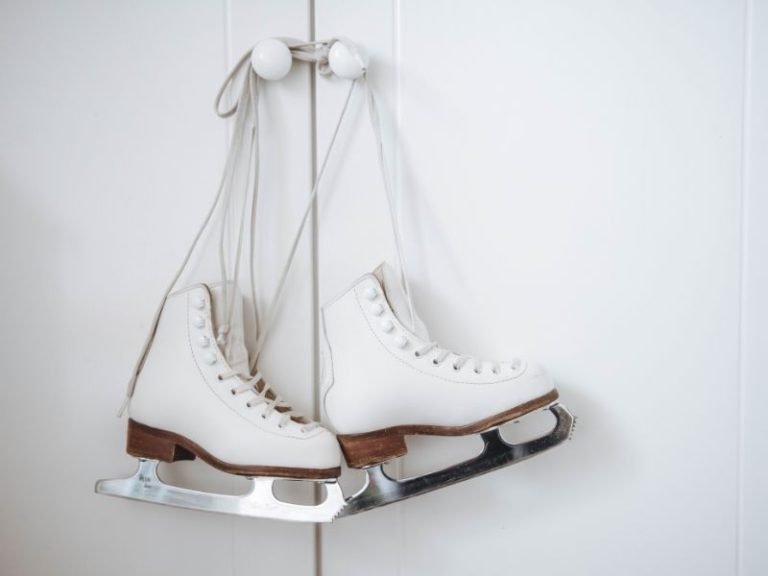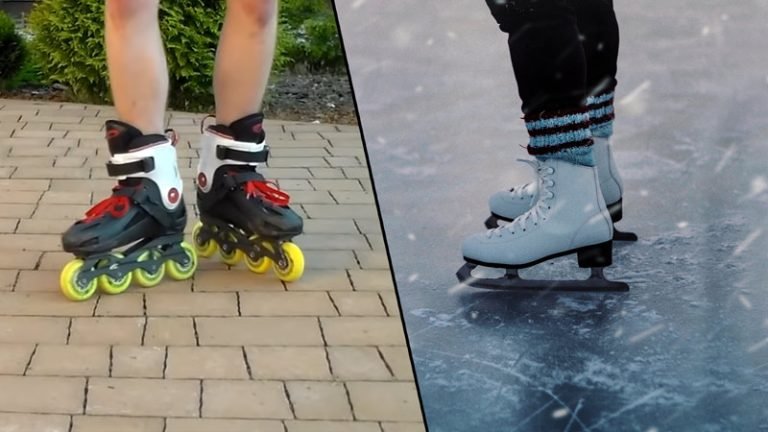Hockey Skates Vs Figure Skates
Hockey skates and figure skates are distinct types of ice skates designed for different purposes. Hockey skates are designed for speed, maneuverability, and quick movements on the ice, while figure skates are designed for precision, control, and graceful movements.
In hockey, players need to be agile and quick on their feet to navigate the fast-paced game, while figure skaters focus on performing intricate routines that require stability and control. The structure of hockey skates supports lateral movement and helps players make quick turns and stops, while figure skates have longer blades and a toe pick at the front to assist with jumps, spins, and intricate footwork.
Understanding the differences between hockey skates and figure skates is essential for choosing the right type of skate based on your specific needs and preferences on the ice. Now, let’s dive deeper into the characteristics, features, and uses of these two types of skates.
Structure And Design
Hockey skates and figure skates differ in their structure and design, catering to the specific needs of each sport. Hockey skates prioritize speed and maneuverability, while figure skates focus on stability and precision for jumps and spins. Choose the right skates based on your skating style and goals.
H3: Anatomy of Hockey Skates: Exploring the unique features and components
Hockey skates are specifically designed to provide athletes with the necessary support, flexibility, and speed on the ice. Understanding the anatomy of hockey skates helps players make informed decisions when it comes to selecting the right pair for their needs.
Let’s delve into the structure and design of hockey skates, starting with the blade.
H3: Blade: The Role Of The Blade In Hockey Skates
- Blade shape and profile: The blade on hockey skates features a unique shape that allows for quick turns and efficient maneuverability. Its profile typically includes a radius of hollow (ROH) that affects grip and turning ability.
- Runner material: Hockey skate blades are usually made of stainless steel due to its durability and resistance to rust. The quality of the steel determines the blade’s performance and longevity.
- Blade edges: Hockey skates have two edges on each blade, namely the outside edge and inside edge. These edges are important for maintaining balance, stability, and enhancing control during rapid movements.
H3: Boot: Understanding the design and construction of hockey skate boots
- Quarter construction: Hockey skate boots consist of a quarter, which is the part of the boot that wraps around the player’s ankle and provides support. The quarters are traditionally made of rigid materials like thermoplastic or carbon fiber for enhanced stability.
- Toe box: The toe box of hockey skate boots is designed to protect the player’s toes while allowing for comfort and flexibility. It is often reinforced with materials like rubber or composite to provide ample protection.
- Ankle padding: Hockey skate boots feature strategically placed padding around the ankles to provide support, reduce friction, and minimize the risk of injuries.
- Tongue: The tongue of hockey skate boots is often thickly padded to protect the player’s foot from lace bite and provide additional comfort and support.
H3: Lacing Systems: Different Lacing Options For Hockey Skates
- Traditional lacing: Hockey skates commonly feature traditional lacing systems that allow players to tighten or loosen their skates based on their preferences. This lacing method offers a customizable fit and easy adjustability.
- Quick-release lacing: Some hockey skates come with quick-release lacing systems that utilize specially designed mechanisms, such as reels or dials, to quickly tighten or release the laces. These systems can save time during the lacing process and provide a secure fit.
- Hybrid lacing: Hybrid lacing systems combine traditional and quick-release lacing methods, offering players the versatility of both options. This allows for a snug fit while enabling quick adjustments when needed.
H3: Anatomy of Figure Skates: Analyzing the distinct elements of figure skates
Figure skates are specifically designed to support the intricate movements and elegant jumps performed in figure skating routines. Let’s take a closer look at the anatomy of figure skates, starting with the blade.
H3: Blade: The Significance Of Figure Skate Blades
- Blade shape and profile: The blade on figure skates has a long, slender profile with a prominent tail to facilitate graceful gliding. Its shape and profile enhance stability, control, and precision during intricate footwork and jumps.
- Hollow-ground edges: Figure skate blades have hollow-ground edges running along their length. This edge profile helps skaters maintain balance and execute precise maneuvers on the ice.
- Pitch: The pitch of the blade refers to the height difference between the front and back parts of the blade. The pitch affects the skater’s posture and the way their weight is distributed, ultimately influencing performance.
H3: Boot: Examining the design and materials used in figure skate boots
- Upper material: Figure skate boots are typically made of durable leather or synthetic materials to provide flexibility, ankle support, and protection. The material used ensures the boot remains comfortable throughout the demanding routines.
- Ankle padding: Figure skate boots often have generous padding around the ankles to offer support and cushioning during jumps and landings.
- Heel counter: The heel counter of figure skate boots is constructed to provide stability and prevent heel slippage, ensuring the skater’s foot stays securely in place.
- Toe pick: One distinctive feature of figure skates is the toe pick, a serrated edge located at the front of the blade. The toe pick aids in executing jumps, spins, and other intricate moves.
H3: Lacing Systems: Comparing Lacing Systems For Figure Skates
- Traditional lacing: Figure skates usually feature traditional lacing systems, allowing skaters to adjust the tightness of their boots according to their individual preferences.
- Lace hooks: Figure skate boots often incorporate lace hooks, which are metal hooks attached to the upper part of the boot. These hooks help secure the laces further up the leg, providing additional support and stability.
- Lace bite protectors: Some figure skates come with lace bite protectors, which are padded components designed to prevent discomfort caused by lace pressure on the upper part of the foot.
Understanding the structure and design of both hockey and figure skates provides valuable insights into their distinctive functionalities. From the blade and boot design to different lacing options, each element plays a crucial role in enhancing the performance and experience of both types of skates.
Players can now make informed decisions when choosing the ideal pair for their specific needs.
Performance And Functionality
Hockey skates and figure skates have distinct differences in performance and functionality. While hockey skates are designed for speed, agility, and quick turns, figure skates prioritize stability and precision for jumps and spins on the ice. Each skate type is tailored to cater to the specific needs of its respective sport.
Hockey Skates: Assessing The Performance Characteristics Of Hockey Skates
Hockey skates are designed specifically for the fast-paced and physical nature of the sport. They offer a range of features that enhance performance and functionality on the ice. Let’s take a closer look at some of the key aspects that define the performance of hockey skates:
Agility And Speed: How Hockey Skates Enhance Movement On Ice
- Lightweight construction allows players to move swiftly and make quick turns.
- Low-cut design enables greater ankle mobility, facilitating agile movements.
- Blade design with a shorter radius of hollow enables better grip and maneuverability on the ice.
Protection And Durability: The Importance Of Safety Features In Hockey Skates
- Reinforced toe caps and heel counters provide protection against impacts and collisions.
- Padded tongues and ankle padding offer cushioning and support while minimizing the risk of injuries.
- Durable materials like synthetic leather and reinforced stitching ensure the skates can withstand the demands of the game.
Stiffness And Flexibility: Finding The Right Balance For Optimal Performance
- Stiffer boots provide better energy transfer, allowing for powerful strides.
- Flexible ankle areas and outsoles enhance balance and responsiveness.
- Blade holders with flex points enable controlled bending for improved agility and quick acceleration.
Figure Skates: Evaluating The Functionality Of Figure Skates
Figure skates are designed with the emphasis on grace and precision, catering to the artistic and technical demands of figure skating. Let’s explore some of the key factors that contribute to the functionality of figure skates:
Precision And Control: How Figure Skates Enable Intricate Footwork
- Fully lined boots offer stability and precise control during intricate footwork sequences.
- Higher boots provide additional ankle support for jumps and landings.
- Toe picks on the front of the blade facilitate toe jumps and pivots, enhancing control on the ice.
Comfort And Fit: The Significance Of Proper Fitting In Figure Skates
- Customizable padding and heat molding options ensure a snug and comfortable fit.
- Supportive arches and contoured footbeds provide additional comfort during long practice sessions.
- Proper fitting reduces the risk of blisters and enables better control and balance.
Blade Performance: Understanding The Impact Of Blade Design On Figure Skaters
- Longer and narrower blades allow for more extended edges, promoting stability and balance.
- Different blade profiles, such as cross-cut or parallel edges, cater to specific skating styles.
- Blade mounting systems with adjustable pitch angles provide customized performance based on individual preferences.
Hockey skates and figure skates are purpose-built for their respective sports, focusing on different performance aspects and functionalities. Whether it’s the agility and speed of hockey skates or the precision and blade performance of figure skates, both play a vital role in elevating the performance of skaters on the ice.
Target Market And Usage
Hockey skates and figure skates cater to different target markets and usage. While hockey skates are designed for fast-paced, aggressive gameplay on ice, figure skates are tailored for elegant, graceful movements and intricate performances on the rink. Each type of skate possesses distinct features that enhance the overall experience for their respective users.
Hockey Skates: Identifying The Ideal Users And Scenarios For Hockey Skates
Hockey skates are specifically designed to meet the demands of the fast-paced and physically demanding sport of ice hockey. Let’s explore the different target markets and usage scenarios for hockey skates.
Professional Players:
- Professional hockey players require high-performance skates that can withstand the intensity of their game.
- These skates are engineered to provide maximum speed, agility, and control.
- They typically have a stiff boot construction and advanced features to enhance performance and durability.
Amateur Players:
- Recreational hockey players, who participate in non-professional leagues or casual games, also benefit from using hockey skates.
- These skates offer a balance of performance and affordability, making them suitable for players on a budget.
- They provide good speed and maneuverability, enabling players to enjoy the game while having some level of competitiveness.
Youth Players:
- For young athletes who are just starting their hockey journey, hockey skates designed specifically for youth players are available.
- These skates prioritize comfort, support, and ease of use to help young players develop their skills and enjoy the sport.
- Safety features are incorporated to protect their growing feet and ankles.
Figure Skates: Analyzing The Target Market And Usage Of Figure Skates
Figure skates are specifically designed for use in figure skating, which combines athletic performance, artistry, and precision. Let’s explore the different target markets and usage scenarios for figure skates.
Competitive Figure Skaters:
- Competitive figure skaters require figure skates that support their high-level maneuvers and jumps.
- These skates provide excellent precision, stability, and control required for performing complex routines.
- The boots are typically made of stiff materials to provide the necessary support and ankle stability.
Recreational Skaters:
- Casual figure skaters, who enjoy skating for leisure and fitness, also opt for figure skates.
- These skates focus on comfort and style, allowing recreational skaters to glide effortlessly on the ice.
- They offer good support and flexibility, making them suitable for various levels of skill and experience.
Learn-To-Skate Programs:
- Figure skates are commonly used in learn-to-skate programs, where beginners learn the basics of figure skating.
- These skates are designed to provide optimal balance, stability, and ease of use for beginners.
- They often have additional safety features to protect learners from falls and injuries.
Hockey skates cater to professional players, amateur players, and youth players, each with their specific needs. On the other hand, figure skates are tailored for competitive figure skaters, recreational skaters, and learners participating in learn-to-skate programs. It’s important to choose the right skates based on one’s skill level, purpose, and personal preferences to enhance performance and enjoyment on the ice.

Credit: www.youtube.com
Frequently Asked Questions Of Hockey Skates Vs Figure Skates
What Are The Main Differences Between Hockey Skates And Figure Skates?
Hockey skates and figure skates differ in blade design, boot construction, and ankle support. While hockey skates have a shorter and more curved blade for agility, figure skates have a longer straighter blade for graceful gliding. Hockey skates also provide better ankle mobility and support for quick turns and stops, while figure skates offer more stability and support for jumps and spins.
Can You Use Hockey Skates For Figure Skating Or Vice Versa?
While it’s technically possible to use hockey skates for figure skating, it’s not recommended. The blade design of hockey skates differs from that of figure skates, affecting the skater’s performance and ability to execute specific moves. Similarly, figure skates are not ideal for hockey as they lack the necessary agility and quick turning ability required in the sport.
Which Type Of Skates Is More Suitable For Beginners?
For beginners, hockey skates are generally more suitable due to their greater ankle support and overall stability. The blade design of hockey skates allows for easier maneuverability and quick stops, making it easier for beginners to learn and control their movements on the ice.
However, it ultimately depends on personal preference and the specific goals of the skater.
Conclusion
The debate between hockey skates and figure skates ultimately comes down to personal preference and the specific needs of the skater. Hockey skates are designed for speed and agility on the ice, with a focus on power and quick movements.
On the other hand, figure skates prioritize stability and precision, allowing skaters to perform intricate movements and jumps. While both types of skates offer their own benefits and are suitable for different purposes, it’s important to choose the skates that best suit your individual goals and style of skating.
Whether you’re a hockey player looking to maximize your performance or a figure skater aiming to perfect your artistic skills, make sure to invest in a high-quality pair of skates that provide the necessary support and comfort. Happy skating!






